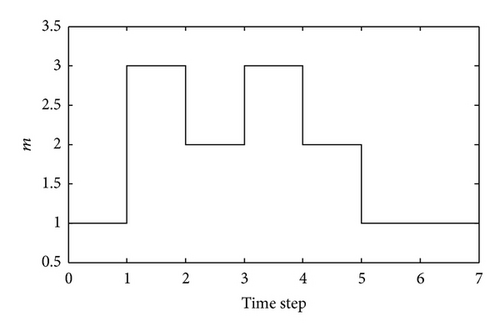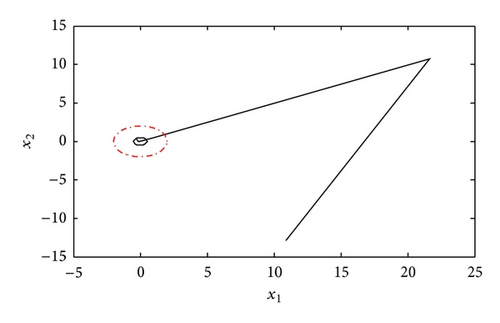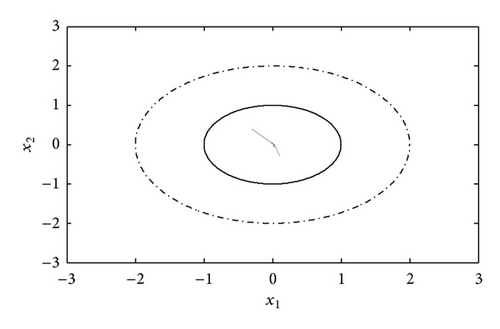Neural Network Based Finite-Time Stabilization for Discrete-Time Markov Jump Nonlinear Systems with Time Delays
Abstract
This paper deals with the finite-time stabilization problem for discrete-time Markov jump nonlinear systems with time delays and norm-bounded exogenous disturbance. The nonlinearities in different jump modes are parameterized by neural networks. Subsequently, a linear difference inclusion state space representation for a class of neural networks is established. Based on this, sufficient conditions are derived in terms of linear matrix inequalities to guarantee stochastic finite-time boundedness and stochastic finite-time stabilization of the closed-loop system. A numerical example is illustrated to verify the efficiency of the proposed technique.
1. Introduction
Markov jump systems (MJSs) are an important class of stochastic dynamic systems, which are popular when modeling an abrupt change in the system structure and parameters, such as component failures or repairs, changing subsystem interconnections and environmental disturbance. This family of systems has great practical potential in a variety of fields, such as solar thermal central receivers systems, economic systems, communication systems, manufacturing systems, and networked control systems [1–4]. MJSs have been extensively studied since the pioneering work on quadratic control of MJSs [5], and many achievements have been made on Lyapunov stochastic stability and stabilization in the last three decades [6–18].
However, it is worth noting that the Lyapunov stochastically stable systems may not possess good or expected transient characteristics over a finite-time horizon. In many practical problems, it is of interest to investigate the stability of a system over a finite interval of time. For example, referring to aircraft control, it requests that, during the execution of a certain task, the state variables should not exceed some threshold under all admissible pilot inputs and in the presence of wind disturbances. Classical control theory does not directly address this requirement, because it focuses mainly on the asymptotic behavior of the system (over an infinite-time interval) and does not usually specify bounds on the trajectories. Therefore, it is necessary to limit the state in an acceptable region and consider finite-time stability (FTS) given by Dorato [19].
The concept of FTS has been further extended into finite-time boundness (FTB) [20, 21], when system possesses bounded exogenous disturbance. A linear matrix inequality (LMI) framework has been established to distinguish FTS and Lyapunov asymptotical stability [22–24]. Compared with Lyapunov stochastically stable condition, FTS relaxes the condition by allowing that the Lyapunov-like function can increase at every sampling time instant. That is why FTS is so attractive and widely used in practical engineering.
As MJSs are considered, a number of results on stochastic FTS or stochastic FTB have been developed [25–28], and recently, the obtained results have been extended to continuous-time MJSs with nonlinearities via fuzzy or neural network approach [24, 29, 30]. In order to make the stochastic systems more manageable and satisfy the requirements for finite-time behavior of a system in engineering fields, it motivates us to investigate the finite-time stability and stabilization problems for a class of MJSs. Furthermore, time delay is a common phenomenon and is inevitable in practice systems [31–33]. Due to the interaction among system dynamics, stochastic jumps, and time delays, the dynamics of MJSs with time delay become more complex than MJSs without time delay and time delay systems without jumps. So far, in comparison with the literatures available for continuous-time nonlinear MJSs with time delays, the corresponding FTS or FTB results for discrete-time nonlinear systems have been relatively few.
It is, therefore, the main purpose of this paper to shorten such a gap by investigating the finite-time stabilization problem for discrete-time nonlinear MJSs with time delays. With neural networks, the nonlinearities of MJSs are approximated firstly by linear difference inclusion under state-space representation. Then, a mode-dependent finite-time controller is developed to make the nonlinear MJSs stochastic finite-time stabilizable for all admissible approximation errors of the neural networks and the norm-bounded external disturbances. The controller gains could be derived by solving a set of LMIs. An attractive feature of the proposed scheme is that the coupling relationship between time delay and given finite-time horizon is explored by obtaining delay-independent conditions.
Notations in this paper are fairly standard. Rn and Rn×m denote n-dimensional Euclidean space and the set of all the n × m real matrices, respectively; AT (or xT) and A−1 denote the transpose of the matrix A (or the vector x) and the inverse of the matrix A, respectively. λmax (A) and λmin (A) denote, respectively, the maximal and minimal eigenvalues of a real matrix A, ∥A∥ denotes the Euclidean norm of matrix A, E{·} denotes the mathematics statistical expectation of the stochastic process or vector, l2[0 N) is the space of summable infinite sequence over [0 N), P > 0 stands for a positive-definite matrix, I is the unit matrix with appropriate dimensions, and “*” means the symmetric terms in a symmetric matrix.
2. System Description and Problem Formulation
Remark 1. The detailed structure and quantitative size of error dynamics Δfi(xk) are not needed, but only norm-bounded assumption is required. This condition is easily satisfied in practical cases, such as bioinformatics system, medical diagnosis, fault diagnosis, and image and pattern recognition. Actually, the approximation error between the target function and the closest neural network function of a given network family can be made as small as desired by increasing the number of nodes [35]. Also the bounds of norm may vary according to different nonlinearities in different modes.
3. Main Results
Definition 2 (stochastic finite-time stability). A discrete-time nonlinear MJS (1) (setting uk = 0 and wk = 0) is said to be, stochastic finite-time stability (FTS) with respect to given (c1, c2, G, N), where c2 > c1 and G > 0, if , k ∈ {1,2, …, N} whenever .
Definition 3 (stochastic finite-time boundness). A discrete-time nonlinear MJS (1) (setting uk = 0) is said to be of stochastic finite-time boundness (FTB) with respect to (c1, c2, G, N, δ) with c2 > c1 and G > 0, if , whenever .
Before proceeding further, we introduce the following lemmas which will be needed for the derivation of our main results.
Lemma 4. The closed-loop system (19) is stochastic FTB with respect to the given (c1, c2, G, N, δ) and scalar α ≥ 0, if there exist mode-dependent symmetric positive-definite matrix Pi and symmetric positive-definite matrices Q and S such that
Proof. For the closed-loop system (19), choose a stochastic Lyapunov function candidate as
Condition (19) implies that, for k ∈ {1,2, …, N}, . This completes the proof.
Now, we direct our attention to present a solution to the problem of finite-time stabilizing controller design. Such controller is provided by the following theorem.
Theorem 5. The closed-loop system (19) is stochastic finite-time stabilizable via state feedback with respect to the given (c1, c2, G, N, δ) and scalar α ≥ 0, if there exist matrices , Yi, H = HT > 0, S = ST > 0, and R = RT > 0 and scalars λ1, λ2, λ3, λ4 > 0 such that
Proof. By using Schur complement, from condition (21) in Lemma 4, it follows that
On the other hand, we consider
Remark 6. It is worth pointing out that Theorem 5 is not a delay-dependent sufficient criterion, which is conservative when the delay is small. Delay-dependent result can be developed in the same way by choosing a Lyapunov functional that includes more entries, as was done in [36], or delay fractioning approach that can be employed as was done in [31–33].
Remark 7. The coupling relationship between time delay and given finite-time horizon of the underlying system is obtained through a finite-time stable constraint (32) in Theorem 5. From condition (32), it can be seen that, in given finite-time horizon, if the time delay d is larger, constraint (32) is more difficult to be satisfied, which means that the existence of time delay increases the instability of system.
4. Numerical Example



It should be pointed out that, in the simulation example, as long as the choice of initial condition is satisfied with , then the system is robustly finite-time stabilizable; that is, system trajectories stay within a given bound.
5. Conclusions
The finite-time stabilization problem for discrete-time Markovian jump nonlinear system with time delay and norm-bounded exogenous disturbance is investigated in this paper. The nonlinearities are parameterized by multilayer neural network and the relationship between time delay and given finite-time horizon is explored with delay-independent conditions. The proposed framework is versatile and can accommodate a number of challenging design problems including finite-time control and filtering of discrete-time or continuous-time nonlinear MJS with parameter uncertainties, time delays, and so on. The future work can consider some delay-dependent approaches or delay fractioning approaches to reduce the conservativeness introduced by time delay.
Acknowledgments
This work was partially supported by the National Natural Science Foundation of China (Grant no. 61104121) and the 111 Project (Grant no. B12018), and the third author would also like to thank the Alexander-von-Humboldt Foundation for providing the support to this research.




